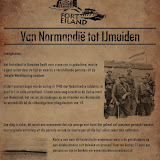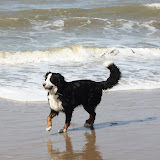Thirteen memorable facts about the Summer Olympics
Tomorrow is the start of the 2008 Summer Olympics in Beijing, China. I'm looking forward to a great sports event. Although I sympathise fully with the protests surrounding these games I hope the sports won't be outshone by politics. After all, the goal of the Olympic Movement is to contribute to building a peaceful and better world by educating youth through sport practised without discrimination of any kind and in the Olympic spirit, which requires mutual understanding with a spirit of friendship, solidarity and fair play. - 1916 — Games cancelled due to World War I.
1940-1944 — Games cancelled due to World War II. - 1936 — The Olympics were coming to Berlin and Adolf Hitler viewed it as a golden opportunity to showcase his country and prove to the rest of the world that his Aryan race was superior. He viewed African-Americans as inferior and chastised the United States for stooping to use these "non-humans." Despite the endless racial epithets and the constant presence of the red and black swastika, Jesse Owens made Hitler eat his words with four gold medals.
- 1960-1964 — Ethiopian Abebe Bikila was an unforgettable sight running along the ancient Appian Way during a warm evening in Rome. The skinny Bikila, running barefoot, flew by the soldiers standing with flaming torches along the darkening course that evening and slowly pulled away from his Moroccan opponent before crossing the finish line at the Arch of Constantine in a world-record time of 2:15:16. Bikila would battle back from an appendectomy to repeat as Olympic marathon champion four years later in Tokyo, becoming the first ever to successfully defend a marathon gold medal.
- 1968 — American sprinters Tommie Smith and John Carlos bowed their heads and raised their black-gloved fists while on the medal podium in Mexico City, marking one of the most famous photographs from any Olympics as well as a memorable milestone in American civil rights. While the protest seems relatively tame by today's standards, the actions of Smith and Carlos were met with such outrage that they were suspended from their national team and banned from the Olympic Village, the athletes' home during the games. The protest had lingering effects for both men, the most serious of which were death threats against them and their families.
- 1968-1972 — Before the 1968 games in Mexico City, American swimmer Mark Spitz predicted he would accomplish what no one else had: to win six gold medals. He ended up with two team golds, plus an individual silver and bronze. It's tough for someone to be disappointed with four Olympic medals, but Spitz was. He spent the next four years at Indiana University, winning almost every conceivable award, setting almost every world record in existence, and preparing himself for the 1972 Olympics in Munich. At Munich, not only did Spitz win the six golds he predicted four years before, he won seven! And not only did he win all seven, but world records were set in each event.
- 1972 — Eight Arab terrorists broke into the athletes' compound in Munich. They killed two members of the Israeli Olympic team and took nine others hostage, demanding the release of 200 guerrillas held in Israel. Israeli leaders denied the release. When both sides agreed to let the terrorists and their hostages out of West Germany, shots rang out as the terrorists walked the hostages onto the jet. It's unclear who fired first, but once the fighting began, the guerrillas killed all nine Israeli hostages. Five of the terrorists were killed.
- 1972-1976 — His long-distance performances in Munich '72 and Montreal '76 gave Lasse Viren sporting immortality. The Flying Finn completed an unprecedented and unlikely-to-be-repeated ‘double double', taking gold in the 5000m and 10,000m at successive Games. Viren originally only intended to run the 5000m in Munich. He had hardly shone in the previous two years but began to peak at the right time. It was a dramatic 10,000m that brought the first of Viren's four gold and the one he most savours to this day.
- 1976 — During the Summer Olympics in Montreal Nadia Comaneci, a 14-year-old, 4-foot-11, 86-pound Romanian became the first male or female to ever receive a perfect 10 score in a gymnastics event. The 14-year-old Romanian dazzled the judges to the point where they couldn't help but give her a perfect 10. And they didn't stop there, for not only did Comaneci receive the first perfect score, she then proceeded to get six more!
- 1980 — The U.S. Hockey team scored a major upset by beating the heavily-favoured Russian team, in what came to be known as the "Miracle on Ice." Sports aside, the game held much more meaning, being played at the height of the Cold War and on U.S. soil in Lake Placid, N.Y. The story was later made into the Disney movie "Miracle."
- 1988 — Jamaica entered the bobsled event, marking a first for the sunny Caribbean country. However, during a run in the '88 games, their sled flipped onto its side, thus eliminating them from contention. The story was later made into the Disney movie "Cool Runnings."
- 1992 — British sprinter Derek Redmond returned to the Barcelona Games in 1992 after having to withdraw in 1988 due to injury. He entered as one of Britain's favourites to win a medal, and easily won the first round and quarter-finals. But in the semi-finals, his hamstring snapped and Redmond went sprawling to the track. It was what he did afterward, though, that cemented him in Olympics lore. Redmond got up and began hobbling toward the finish line. Unable to continue very far, he again fell. A moment later, his dad appeared at his side, at first to talk him out of trying to continue. But when Redmond still tried to get up and keep running, his dad put his arm around him and helped his son around the track. The race was long over, and officially he got a disqualification, but the crowd gave Redmond and his father a standing ovation as he completed the remaining distance of the race.
- 1996 — It was a small event, but impacted and touched many observers. When former boxing champion Muhammed Ali held the Olympic torch at the opening ceremonies of the Summer Games in Atlanta, Georgia, it brought tears to many eyes. Visibly shaking from Parkinson's disease, Ali lit the cauldron as the arena chanted his name over and over again.
- Paralympics —The Paralympic Movement started in 1948, when a sports competition was organized for persons with a disability during the London Olympic Games. In 1960, two weeks after the Rome Olympic Games, 400 athletes from 23 countries participated in Olympic style games organized for the first time for the disabled in Rome. These were the first Paralympic Games. The Beijing 2008 Paralympic Games will be the 13th Paralympics. Today, the Paralympics are elite sport events for athletes from six different disability groups. They emphasize, however, the participants' athletic achievements rather than their disability. On 19 June 2001, an agreement was signed between IOC and IPC securing this practice for the future. From the 2012 bid process onwards, the host city chosen to host the Olympic Games will be obliged to also host the Paralympics.
sources:
Fox News , Infoplease , Associated Content , The Street , Times of India , Paralympics 2008 , Official Site Beijing 2008
~*~*~*~
Links to other Thursday Thirteens!
~*~ Chelle Y. ~*~ Anthony North ~*~ Nicholas ~*~ Claudia ~*~ Sandy Carlson ~*~ Lilibeth ~*~ Lori ~*~ Meju ~*~ Lisa ~*~ Yasmin ~*~ Adelle ~*~ Danielle ~*~ Nina ~*~ B Boys Mom ~*~ Marcia ~*~ Kristi ~*~ I Must Confess ~*~ Carol ~*~ Tempest Knight ~*~ Dera ~*~ Chris ~*~ Heather ~*~ RaenWa ~*~ storyteller ~*~ Puss Reboots ~*~ Elaine ~*~ Gayle ~*~
Get the Thursday Thirteen code here!
The purpose of the meme is to get to know everyone who participates a little bit better every Thursday. Visiting fellow Thirteeners is encouraged! If you participate, leave the link to your Thirteen in others comments. It’s easy, and fun! Be sure to update your Thirteen with links that are left for you, as well! I will link to everyone who participates and leaves a link to their 13 things. Trackbacks, pings, comment links accepted!
View More Thursday Thirteen Participants |



.jpg)



























